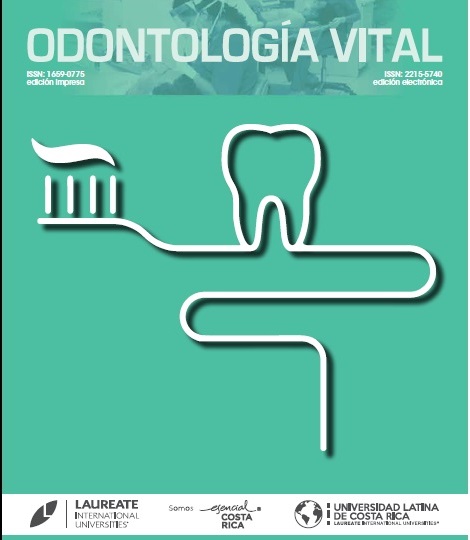Comparison between the manual system of stainless steel files and the rotating system of nickel titanium files in the conformation of curved radicular ducts in vitro
DOI:
https://doi.org/10.59334/ROV.v2i31.324Keywords:
Manual endodontic system, FKG Race® endodontic system, curved canals, radius of curvature, first lower molarsAbstract
Introduction: An experimental study was carried out to compare the effect of the manual system and the rotary system on the conformation of curved conduits.
Methodology: A sample of 40 mesial roots of lower first molars was randomized into two equal groups: group manual system of K-files and group rotary system FGK Race®. The radius of the final curvature vs. the initial curvature was compared using the Autocat 2015 program. The t-test with a significance of 0.05 was used.
Results: The curvature radius varied significantly for both the manual system and the rotary FGK Race® (p = 0.0001 and p = 0.0013, respectively). In addition, the manual system produced greater variation in the radius of the curvature when compared to the rotary system 2.23mm vs. 1.27mm respectively; p = 0.13.
Conclusion: Both systems produced modification on the conformation of the conduits of the mesial roots; however, in the comparison between both systems said differences were not significant.
Downloads
References
Aguirre, G., Geraldes, P., Rivas, G., Nogueira, I., Bonetti-Filho, I., García, P., Leonardo, R. (2007). Efectividad de las técnicas rotatoria y oscilatoria en la preparación de conductos radiculares de conformación ovalada. Acta odontol venez; 45(4): 528-33.
Alcota, M., Compán, G., Salinas, J., Palma, A. (2011). Estudio comparativo in vitro de la transportación del canal radicular, utilizando tres sistemas rotatorios de Níquel-Titanio: HERO Shaper, ProTaper Universal y RaCe. Rev Fac Odontol Univ Antioq; 23(1): 9-20.
Aracena, D., Borie, E., Fuentes, R., Boldt, F., Aracena, A., Valenzuela, R. (2013). Evaluación in vitro de la preparación de conductos mesiales de molares con instrumentos manuales NI-TI y Protaper Universal rotatorio. Av. Odontoestomatol; 29(2): 73-79. https://doi.org/10.4321/S0213-12852013000200003
Berástegui, E., Ballester-Palacios, ML., Rivas-Frau, X., Mercade, M., Canalda, C. (2016). Evaluación de la lima Proglider para crear una vía de deslizamiento en conductos curvos usando tomografía computadorizada de haz cónico. Endodoncia (Madr); 34(4): 193-203.
Chen, J., Messer, H. (2002). A comparison of stainless steel hand and rotary nickel-titanium instrumentation using a silicone impression technique. Aust Den J; 47(1): 12-20. https://doi.org/10.1111/j.1834-7819.2002.tb00297.x
García-Sanz, C., Llamosas-Hernández, E., Verdugo-Barraza, M., Castro-Salazar, G., (2010). Desviación del conducto original por el uso de los sistemas rotatorios Mtwo y Protaper. Rev Odontol Latinoam; 2(2): 25-31.
Guzmán, C., Salazar, D., González, F., Alcota, M. (2013). Grado de transportación del canal radicular de tres sistemas de instrumentación rotatoria: estudio a través de tomografía computadorizada Cone Beam. Rev Fac Odontol Univ Antioq; 24(2): 180-201.
Hartmann, M., Barletta, F., Camargo Fontanella, V., Vanni, J. (2007). Canal transportation after root canal instrumentation: A comparative study with computed tomography. J Endod; 33: 962–65. https://doi.org/10.1016/j.joen.2007.03.019
Loizides, A., Eliopoulos, D., Kontakiotis, E. (2006). Root canal transportation with a Ni- Ti rotary file system and stainless steel hand files in simulated root canals. Quintessence Int; 37(5): 369-74.
Nagaraja, S., Sreenivasa Murthy B. (2010). CT evaluation of canal preparation using rotary and hand NI-TI instruments: An in vitro study. J Conserv Dent; 13: 16-22. https://doi.org/10.4103/0972-0707.62636
Rocha, A., Cecco, P., Silva-Herzog, D., Dávila, C., Loredo, A. (2017). Comparación del transporte apical producido por diferentes sistemas rotatorios en donductos radiculares curvos. En: VIII Congreso Nacional de Tecnología Aplicada a Ciencias de la Salud. Monterrey, Nuevo León, México. 15, 16 y 17 de junio de 2017.
Schafer, E., Erler, M., Dammaschke, T. (2006). Comparative study on the shaping ability and cleaning efficiency of rotary Mtwo instruments. Part 1. Shaping ability in simulated curved canals. Int Endod J; 39(3): 196-202. https://doi.org/10.1111/j.1365-2591.2006.01074.x
Walia, H., Brantley, W., Gerstein, H. (1988). An initial investigation of the bending and torsional properties of Nitinol root canal files. J Endod; 14: 346–51. https://doi.org/10.1016/S0099-2399(88)80196-1
Downloads
Published
Issue
Section
License
Copyright (c) 2019 Johanna Elizabeth Quiroz-Málaga, Wilfredo Fidel Ramos-Torres, Elias Ernesto Aguirre-Siancas

This work is licensed under a Creative Commons Attribution 4.0 International License.
Authors who publish with Odontología Vital agree to the following terms:
- Authors retain the copyright and grant Universidad Latina de Costa Rica the right of first publication, with the work simultaneously licensed under a Creative Commons Attribution 4.0 International license (CC BY 4.0) that allows others to share the work with an acknowledgement of the work's authorship and initial publication in this journal.
- Authors are able to enter into separate, additional contractual arrangements for the non-exclusive distribution of the Odontología Vital's published version of the work (e.g., post it to an institutional repository or publish it in a book), with an acknowledgement of its initial publication.
- Authors are permitted and encouraged to post their work online (e.g., in institutional repositories or on their website) prior to and during the submission process, as it can lead to productive exchanges, as well as earlier and greater citation of published work.







